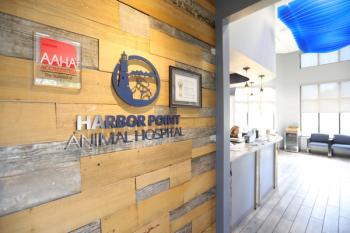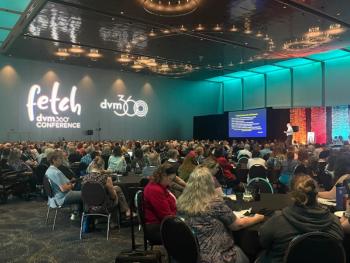
Incoming AAHA president
Dr. Michael Thomas weighs in on time, pain management, c.e., teamwork
Practice inefficiency, sagging income and market saturation top the primary concerns of the incoming president of the American Animal Hospital Association (AAHA).
"How many clinics or hospitals are working anywhere near capacity?"asks Dr. Michael Thomas. "How much time is wasted working in an inefficientfacility? It may be due to a poor layout, inadequate equipment, or morecommonly, not enough well-trained staff."
Thomas, who earned his associate degree from Miami Dade Junior Collegein 1963 and received his DVM with honors from Auburn University in 1968,owns seven hospitals in Indiana. The AAHA President-elect will take officeat the association's annual meeting in San Antonio, March 10-14.
Many practice owners, Thomas says, fail to maximize their time and findthemselves doing the tasks of their employees.
"The answer is (finding) better-trained staff from technician schoolsand running a more efficient profession that can pay these people a livingwage so they can stay in the profession," he says.
Students may already be shying from veterinary medicine because of decreasedsalary potential, Thomas says.
"It's very difficult for a student to come out of school and makeenough money to pay their student loans and have the nice life that theyshould have after all those years of study," says Thomas. "It'snot that most practice owners are greedy, it's a matter of them just notgenerating enough money to support them. We need to charge appropriatelyfor our time."
And time must be better managed on a daily basis, Thomas advises.
"If you look in most veterinary hospitals' appointment books, theyhave 'x' amount of appointments available for a day," says Thomas."There's a great portion of those that are not filled. When they'renot filled, that's time where there is no money generated to pay the veterinarian,for the building and equipment and the staff."
He says this issue must be addressed before people are driven from theprofession.
Continuing education
Also on Thomas' priority list for his 2001-02 term is to revise continuingeducation.
"In my generation, we classically practiced hard and went off tomeetings together, (by participating in) continuing education and readingjournals," says Thomas.
He says in today's profession, as information technology rapidly evolvesthrough modalities such as the Veterinary Information Network, the associationmust look at new, viable ways for people to receive their continuing education.The education issue is becoming increasingly influenced by the changingface of the profession. Thomas says that by 2004, the profession will becomprised of 50 percent women, a significant shift in gender over the pastseveral decades.
He believes it is up to AAHA to evaluate educational solutions such asprograms that could be beamed by satellite or videotapes that could be viewedwhile handling the responsibilities of parenting.
"If a person has to take time out to be a parent, then it is easyfor them to get behind unless we come up with some way for them to keepup-to-date," says Thomas.
On the practice front
The new president plans to coordinate development of pain managementguidelines for small animal veterinarians to use pre-operatively and post-operatively in the hospital and at home.
"For many years, veterinarians were taught that pain in animalswas not nearly as big an issue as it was for a person. When there was pain,it was helpful, because it helped keep them (the animals) immobilized sothey wouldn't hurt themselves from recovery of, say, an orthopedic surgery,"explains Thomas.
However, that view has changed dramatically, according to Thomas, whosays the general consensus now is that "animals do perceive pain andwe can shorten recovery times ... if we use more proper pain management,"he says.
"We'd like to get together some expert opinions and come up withwhat is the state of the art in pain management and make that public,"he suggests.
Along with official guidelines, Thomas recommends AAHA develop a seminarseries that stresses key elements of pain management.
Vaccination protocols
In another area of practice, Thomas believes re-evaluation of vaccinationprotocols is overdue.
Traditionally dogs and cats have been vaccinated every year for mosttypes of conditions. But now, Thomas says, certain recommendations indicatethat some vaccinations are not necessary for every disease.
"Some feline practitioners have come out with new guidelines thatdecrease the frequency of new vaccines," he says.
However, veterinarians have traditionally relied on vaccinations as ameans to mobilize clients to visit the clinic annually. During the visit,veterinarians can examine the animals to try to detect other diseases.
"If they (clients) are not coming in every year, you don't havea chance to see them (the animals) regularly. It's incumbent upon us tohelp people understand that one of the more important things than the visitis the physical examination itself.
"Changing vaccination protocols has the potential to hurt incomein a veterinary practice unless managers plan for it," Thomas says."A shift toward more and better medical and surgical services at anappropriate fee cannot only make up for this shift but make practicing morefun and interesting."
Everyone has a say
Thomas believes in the power of communication and as proof he plans toestablish a customized communications initiative during his term.
"If we want to get the word out about a dental meeting, everyone(currently) receives the same thing via brochure," he says. But, "theremay be some people who would rather get the information by e-mail, by FAXor by a phone call. Rather than blanket everyone with a communication thatmay or may not be effective ... find out what works for each individualand be able to customize that if possible."
In today's age, an enormous amount of communication is wasted. "We'reall barraged with much information and no one has time to go through itall," says Thomas, who believes the customized approach would betterserve the AAHA member's needs.
One final word
At least one initiative, established by outgoing president Dr. ThomasCusick, still weighs on Thomas' mind: practice team membership. He saysthe new focus on membership has not only been well received but is already200 percent above expectations.
"I would like members to understand the value of all members ofthe pet health care team being involved not only in AAHA membership butproviding input on the management of the hospital," says Thomas. "Thereare lots of smart people working for practices around the country who arenot veterinarians. We need to listen to them and let them contribute notonly their time but also ideas to our practices."
Newsletter
From exam room tips to practice management insights, get trusted veterinary news delivered straight to your inbox—subscribe to dvm360.




